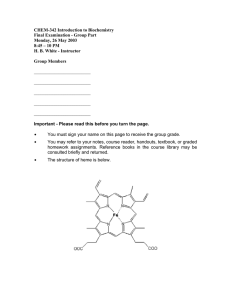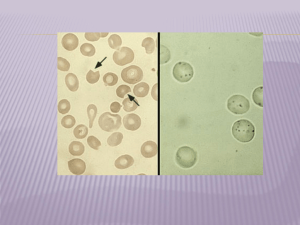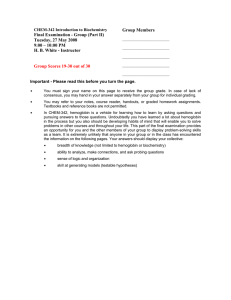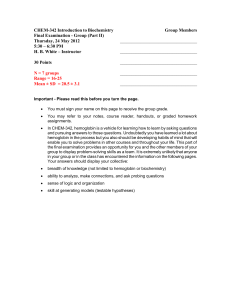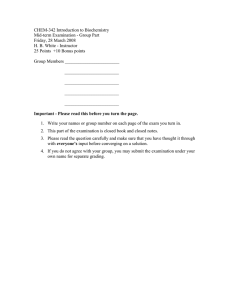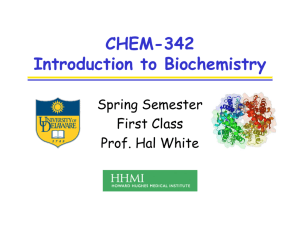CHEM-342 Introduction to Biochemistry Final Examination - Individual Part
advertisement
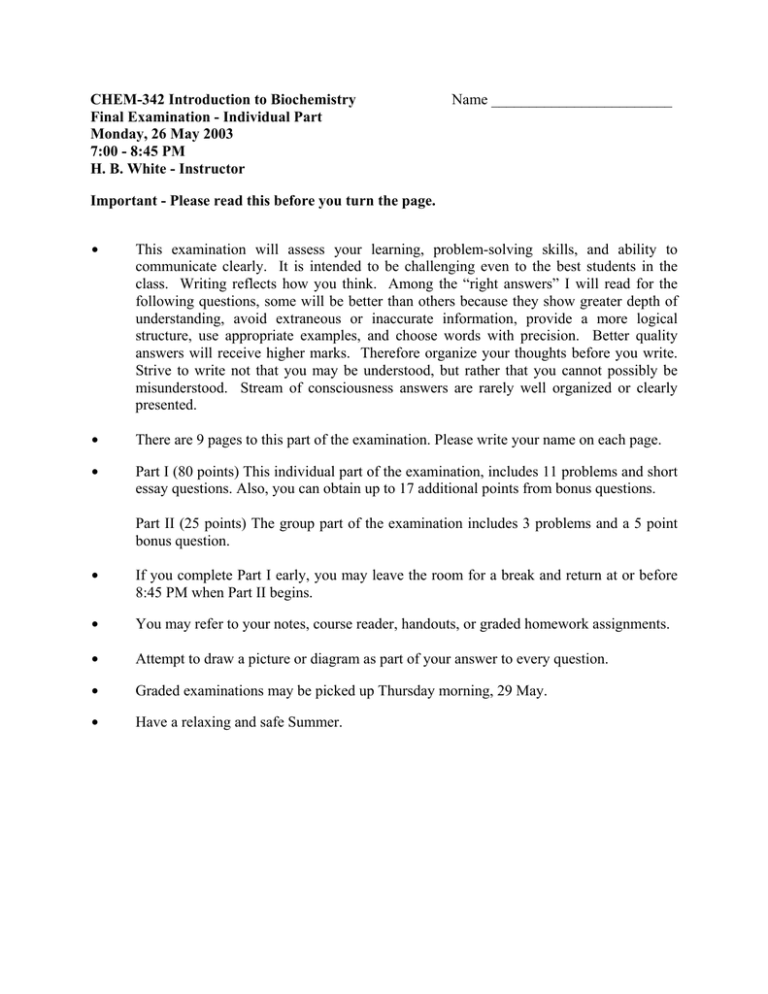
CHEM-342 Introduction to Biochemistry Final Examination - Individual Part Monday, 26 May 2003 7:00 - 8:45 PM H. B. White - Instructor Name ________________________ Important - Please read this before you turn the page. $ This examination will assess your learning, problem-solving skills, and ability to communicate clearly. It is intended to be challenging even to the best students in the class. Writing reflects how you think. Among the “right answers” I will read for the following questions, some will be better than others because they show greater depth of understanding, avoid extraneous or inaccurate information, provide a more logical structure, use appropriate examples, and choose words with precision. Better quality answers will receive higher marks. Therefore organize your thoughts before you write. Strive to write not that you may be understood, but rather that you cannot possibly be misunderstood. Stream of consciousness answers are rarely well organized or clearly presented. $ There are 9 pages to this part of the examination. Please write your name on each page. $ Part I (80 points) This individual part of the examination, includes 11 problems and short essay questions. Also, you can obtain up to 17 additional points from bonus questions. Part II (25 points) The group part of the examination includes 3 problems and a 5 point bonus question. $ If you complete Part I early, you may leave the room for a break and return at or before 8:45 PM when Part II begins. $ You may refer to your notes, course reader, handouts, or graded homework assignments. $ Attempt to draw a picture or diagram as part of your answer to every question. $ Graded examinations may be picked up Thursday morning, 29 May. $ Have a relaxing and safe Summer. CHEM-342 Introduction to Biochemistry Final Examination-Individual Part, 26 May 2003 Name________________________________________ Page 2 1. (5 points) You were asked to attend two biochemistry-related research seminars this semester. Describe one. (Speaker, topic, anything you learned) 2. (5 points) Crystals of deoxyhemoglobin crack and disintegrate when exposed to oxygen. What would be a reasonable explanation for this? 3. (4 points) When present, what does jaundice indicate? 4. (5 points) As is shown in the metabolic pathway below, threonine, an amino acid with two chiral centers, along with pyruvate provide carbon for the biosynthesis of isoleucine, the only other common amino acid with two chiral centers. Put CHEM-342 Introduction to Biochemistry Final Examination-Individual Part, 26 May 2003 Name________________________________________ Page 3 circles around the carbon atoms of isoleucine that are derived from pyruvate. [Trivia: For reasons unknown, isoleucine is the only amino acid of the common 20 amino acids that is not usually present in human hemoglobin.] 5. (6 points) Red blood cells contain lots of glutathione (GSH), the tripeptide shown below. Among other things, GSH protects cells by scavenging reactive oxidants and forming the GSSG oxidized dimer (see question 9). In the space below, draw the structures of the three amino acids generated in the complete acid hydrolysis of glutathione. Identify each of the amino acids. CHEM-342 Introduction to Biochemistry Final Examination-Individual Part, 26 May 2003 Name________________________________________ Page 4 6. (5 points) The following is a short news item from the Wilmington News Journal Wednesday, 21 May 2003. OXFORD, Iowa – A father who went to get help after his SUV got stuck along a water-logged rural road returned to find his wife and five children unconscious from carbon monoxide poisoning. His oldest child, 9 year old Cassandra, died after the accident. The other children ages 8, 4, 3, and 16 months remained in guarded condition the family said Monday. The mother Debra Maier, 29, was released from the hospital. Explain the cause of death in carbon monoxide poisoning? CHEM-342 Introduction to Biochemistry Final Examination-Individual Part, 26 May 2003 Name________________________________________ Page 5 Problem-Solving With hemoglobin comprising more than 90% of the protein in a red blood cell, it might seem that the remaining protein is insignificant. Not so. For example, enzymes and other red cell proteins perform vital metabolic roles. Due to the absence of mitochondria, red blood cell metabolism proceeds almost anaerobicly in the midst of oxygen surplus. Bathed in plasma maintained at ~5mM glucose, red cells use glucose via glycolysis and the pentose phosphate pathway to sustain hemoglobin function. 7. (10 points) One of the compounds formed in the breakdown of glucose to pyruvate and lactate in red cell glycolysis is 2,3diphosphoglycerate (DPG), the structure on the left. In mammalian red blood cells, the concentration of DPG matches that of hemoglobin. It binds tightly, one mole per deoxyhemoglobin tetramer, but does not bind to oxyhemoglobin, as is depicted in the equation below. Hb(O2)4 + DPG ↔ Hb•DPG + 4O2 In the absence of DPG, hemoglobin binds oxygen about 10 times more tightly than it does in a normal red blood cell. Part of the acclimatization that occurs when people go to high altitudes is the physiological adjustment of DPG levels to optimize the binding and release of oxygen at the lower oxygen pressures. (8 points) In the space below, draw and label a diagram relating the percent saturation of hemoglobin with and without DPG as a function of oxygen partial pressure. Then draw a dashed line corresponding to the binding properties needed at high altitude. % Saturation of Hemoglobin 100 Capillary Oxygen 0 Atmospheric Oxygen Partial Pressure of Oxygen (2 points) Predict whether the concentration of DPG in red blood cells increases or decreases in people at high altitude. Explain your prediction. 3 point bonus: Does DPG bind to the heme group in deoxyhemoglobin? Explain. CHEM-342 Introduction to Biochemistry Final Examination-Individual Part, 26 May 2003 Name________________________________________ Page 6 8. (10 points) “Role of Free Radicals in Red Cells” Oxygen is a highly reactive molecule that is toxic to anaerobic cells that cannot use or destroy it. In the red cell, oxygen occasionally does react and the red cell contains systems coupled to glucose metabolism to deal with oxidative damage of various sorts. For example, in the presence of oxygen, some hemoglobin naturally oxidizes to methemoglobin, which can no longer bind oxygen. The enzyme NADH-cytochrome b5 reductase (also known as methemoglobin reductase or NADH diaphorase) uses NADH generated from NAD by glycolysis as a reductant to regenerate hemoglobin. People who genetically lack this enzyme have significant amounts of methemoglobin (~30%) in their blood and have bluish skin color (cyanosis), but are not sick. If these people with methemoglobinemia take a pill containing methylene blue each day, it gives them normal skin color. Draw and label a diagram that summarizes the above paragraph and includes glyceraldehyde-3-phosphate dehydrogenase, the NADH-generating reaction of glycolysis below. 5 point bonus: Methemoglobin is brown. Generate a reasonable explanation for why people with methemoglobinuria are blue. 2 point bonus: In what context did Dr. Allison mention, “The role of free radicals in red cells?” CHEM-342 Introduction to Biochemistry Final Examination-Individual Part, 26 May 2003 Name________________________________________ Page 7 9. (10 points) As with hemoglobin, mutations in the genes encoding any protein can have serious consequences for red blood cells and the health of the affected individuals. One of these proteins is glucose-6-phosphate dehydrogenase (G6PD). G6PD deficiency is the most common human enzymopathy. As noted by Dr. Allison during his visit, one common variant of G6PD appears to provide some protection from malaria. The discovery of this enzyme variant and its mode of action have a long and interesting biochemical history. For ages some otherwise normal people, usually men living in Mediterranean countries, would have dangerous hemolytic episodes after eating fava beans. Favism, as it is known, is a sexlinked condition. The symptoms include dark or black urine a day or two after eating fava beans, weakness and lethargy, temporary anemia, and jaundice. In the 1920’s, primaquine, a then new antimalarial drug related to quinine, was introduced and thought to have no serious side effects. However, when given to people susceptible to favism, the symptoms of favism appeared. Interestingly, after the episode, the physical symptoms disappeared despite the continued use of primaquine. Analysis of the patients who recovered showed an increased proportion of immature red blood cells in their blood. Much later an electrophoretic variant of G6PD was found to have a high frequency in certain Mediterranean populations exposed to malaria. Characterization of this G6PD showed that it was unstable and lost activity as the red blood cell aged. Individuals with this variant were sensitive to fava beans, primaquine, and a variety of other drugs and chemicals that have nothing to do with malaria. Apparently, these compounds create an oxidative stress in red blood cells and generate peroxides in reactions with oxygen. The peroxides are destroyed using the NADPH generated by G6PD and reactions with glutathione as shown below. Based on the properties of the G6PD variant, propose a plausible hypothesis for why people recover from their hemolytic anemia attack despite their continued use of primaquine. Include the evidence in support of your hypothesis. 2 point bonus: Predict which chromosome carries the gene for human G6PD. CHEM-342 Introduction to Biochemistry Final Examination-Individual Part, 26 May 2003 Name________________________________________ Page 8 Part III - Short Essays 10. (10 points) When students read about the experiments done by Dr. Allison to test his hypothesis that sickle cell hemoglobin confers resistance to malaria, they often are shocked. Dr. Allison was asked about the ethical aspects of his experiment during his visit to our class. What did he say? Were you satisfied with his answer? Why or why not? CHEM-342 Introduction to Biochemistry Final Examination-Individual Part, 26 May 2003 Name________________________________________ Page 9 11. (10 points) People who have sickle cell trait have a ~60:40 ratio of HbA to HbS in their red blood cells when one might expect a 50:50 ratio. What are some possible explanations for the unequal ratio? 5 point bonus. Dr. Kwaku Ohene-Frempong, who is himself a sickle cell carrier, provided evidence for a particular hypothesis to explain the 60:40 ratio. What was his explanation?
